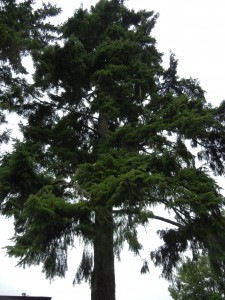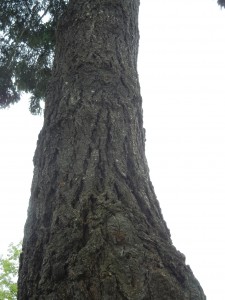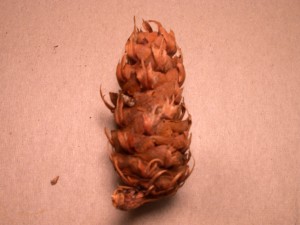by Derek Fung
The Douglas-Fir
Pseudotsuga menziesii
 The Douglas-Fir, with the scientific name Pseudotsuga menziesii, is an evergreen conifer species native to western North America from the family Pinaceae. Its common name, Douglas-fir, is a misnomer as it is not a true fir from the Abies genus, hence the hyphenation in its name. In addition, it was given its own genus, Pseudotsuga, meaning false hemlock. P. menziesii. Its common name comes from the Scottish botanist and early explorer David Douglas. The specific epithet, menziesii, is after another Scottish botanist by the name of Archibald Menzies. It originates from Pacific Northwest and is abundant in western North America from British Columbia to Mexico. In this region, there are two varieties of the Douglas-fir: coastal and Interior.
The Douglas-Fir, with the scientific name Pseudotsuga menziesii, is an evergreen conifer species native to western North America from the family Pinaceae. Its common name, Douglas-fir, is a misnomer as it is not a true fir from the Abies genus, hence the hyphenation in its name. In addition, it was given its own genus, Pseudotsuga, meaning false hemlock. P. menziesii. Its common name comes from the Scottish botanist and early explorer David Douglas. The specific epithet, menziesii, is after another Scottish botanist by the name of Archibald Menzies. It originates from Pacific Northwest and is abundant in western North America from British Columbia to Mexico. In this region, there are two varieties of the Douglas-fir: coastal and Interior.
P. menziesii is a large evergreen conifer gymnosperm that can reach heights of 85 metres in its coastal variety, P. menziesii var. menziesii, and 42 metres in its Interior variety, P. menziesii var. glauca. It thrives in well-aerated, deep soils of slightly  acidic pH of 5 to 6. It is a dominant keystone species that thrives in large areas and its success is due to the periodic recurrence of catastrophic wildfires that eliminated other species that were more vulnerable to wildfires. It has a lengthy lifespan, with the oldest specimen from Vancouver Island measuring a ring-count age of 1350. P. menziesii can be identified by the smooth texture and grey-brown colour of its distinctive bark that is embedded with resin-filled blisters. The bark thickens with age and becomes deeply grooved with dark reddish-brown ridges.
acidic pH of 5 to 6. It is a dominant keystone species that thrives in large areas and its success is due to the periodic recurrence of catastrophic wildfires that eliminated other species that were more vulnerable to wildfires. It has a lengthy lifespan, with the oldest specimen from Vancouver Island measuring a ring-count age of 1350. P. menziesii can be identified by the smooth texture and grey-brown colour of its distinctive bark that is embedded with resin-filled blisters. The bark thickens with age and becomes deeply grooved with dark reddish-brown ridges.
The leaves of P. menziesii are flat needles with pointed tips. The upper surface of the needles is bright yellow-green with a single groove bisecting the centre. The lower surface of the needle is more pale in colour. The reproductive cycle of P. menziesii takes over a span of 17 months, which begins in early April and ends in late September of the following year. The reproductive cycle consists both sexual and asexual reproduction. P. menziesii is monoecious and possesses sexual organs that contain both male and female organs for reproduction.
The reproductive cycle of P. menziesii takes over a span of 17 months, which begins in early April and ends in late September of the following year. The reproductive cycle consists both sexual and asexual reproduction. P. menziesii is monoecious and possesses sexual organs that contain both male and female organs for reproduction.
A mature P. menziesii specimen begins producing cones for reproduction at 12 to 15 years of age. The male cones are 2 centimeters long and yellow or dark red in colour. The female cones are larger, measuring at 3 centimeters long and are distinctively
 green or dark red in colour. The female cones have specialized modified leaves that are pitchforked-shape called bracts and can begin pollination immediately at maturity. Mature cones are 8 to 10 centimeters long and the bracts turn brown at maturity. Germination of seeds occur from mid-March to early April, but halts in the midsummer until April of the following year due to the high amounts of moisture of the season. Ideal conditions for seed germination include growth in moist, mineral soil, increased exposure to sunlight as the tree ages.
green or dark red in colour. The female cones have specialized modified leaves that are pitchforked-shape called bracts and can begin pollination immediately at maturity. Mature cones are 8 to 10 centimeters long and the bracts turn brown at maturity. Germination of seeds occur from mid-March to early April, but halts in the midsummer until April of the following year due to the high amounts of moisture of the season. Ideal conditions for seed germination include growth in moist, mineral soil, increased exposure to sunlight as the tree ages.
P. menziesii is widely used by Aboriginal people in southern British Columbia for its wood as a fuel source for pit cooking. The tree is also used to make fishing hooks and for carpentry in Aboriginal communities. It is also the one of the best timber producing trees and has a large importance in the logging industry. Hence, its wood is still highly valued for its strength and durability that makes it an ideal material for construction.
References
Cook, Morgan. “Coast Douglas Fir.” Coast Douglas Fir. University of Wisconsin-La Crosse, 2008. Web. 20 Mar. 2014. <http://bioweb.uwlax.edu/bio203/s2009/cook_morg/Reproduction.htm>.
“Douglas-fir.” Douglas-fir. Ministry of Forests, Lands and Natural Resource Operations. Government of British Columbia, n.d. Web. 19 Mar. 2014. <http://www.for.gov.bc.ca/hfd/library/documents/treebook/douglasfir.htm>.
Earle, Christopher J., ed. “Pseudotsuga Menziesii Var. Menziesii (coast Douglas-fir)
Description.” The Gymnosperm Database. 2013. Web. 20 Mar. 2014. <http://www.conifers.org/pi/Pseudotsuga_menziesii_menziesii.php>.
Jensen, Ed, et al. “Douglas-fir Genus: Common Trees of the Pacific Northwest.” Douglas-fir Genus: Common Trees of the Pacific Northwest. College of Forestry, Oregon State University, n.d. Web. 20 Mar. 2014. <http://oregonstate.edu/trees/conifer_genera/douglas_fir.html>.
Previous: Pinus ponderosa Next: Sciadopitys verticillata
